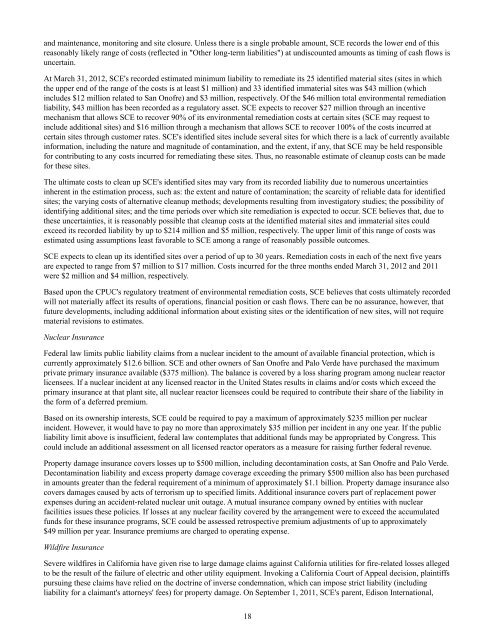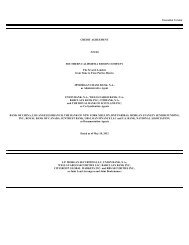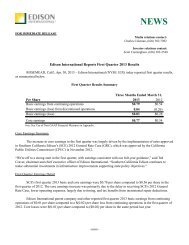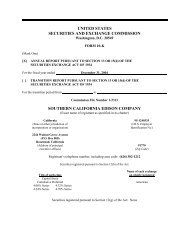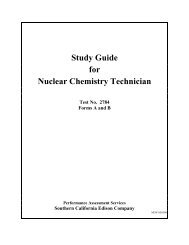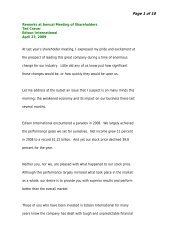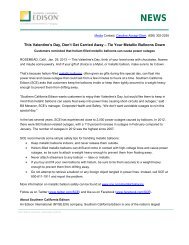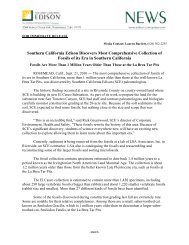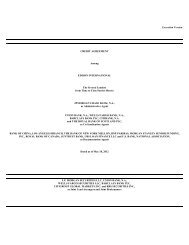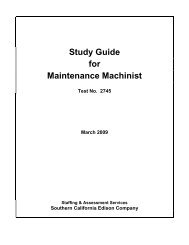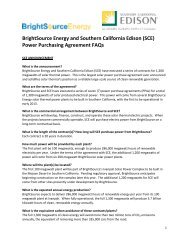10-Q - Edison International
10-Q - Edison International
10-Q - Edison International
You also want an ePaper? Increase the reach of your titles
YUMPU automatically turns print PDFs into web optimized ePapers that Google loves.
and maintenance, monitoring and site closure. Unless there is a single probable amount, SCE records the lower end of thisreasonably likely range of costs (reflected in "Other long-term liabilities") at undiscounted amounts as timing of cash flows isuncertain.At March 31, 2012, SCE's recorded estimated minimum liability to remediate its 25 identified material sites (sites in whichthe upper end of the range of the costs is at least $1 million) and 33 identified immaterial sites was $43 million (whichincludes $12 million related to San Onofre) and $3 million, respectively. Of the $46 million total environmental remediationliability, $43 million has been recorded as a regulatory asset. SCE expects to recover $27 million through an incentivemechanism that allows SCE to recover 90% of its environmental remediation costs at certain sites (SCE may request toinclude additional sites) and $16 million through a mechanism that allows SCE to recover <strong>10</strong>0% of the costs incurred atcertain sites through customer rates. SCE's identified sites include several sites for which there is a lack of currently availableinformation, including the nature and magnitude of contamination, and the extent, if any, that SCE may be held responsiblefor contributing to any costs incurred for remediating these sites. Thus, no reasonable estimate of cleanup costs can be madefor these sites.The ultimate costs to clean up SCE's identified sites may vary from its recorded liability due to numerous uncertaintiesinherent in the estimation process, such as: the extent and nature of contamination; the scarcity of reliable data for identifiedsites; the varying costs of alternative cleanup methods; developments resulting from investigatory studies; the possibility ofidentifying additional sites; and the time periods over which site remediation is expected to occur. SCE believes that, due tothese uncertainties, it is reasonably possible that cleanup costs at the identified material sites and immaterial sites couldexceed its recorded liability by up to $214 million and $5 million, respectively. The upper limit of this range of costs wasestimated using assumptions least favorable to SCE among a range of reasonably possible outcomes.SCE expects to clean up its identified sites over a period of up to 30 years. Remediation costs in each of the next five yearsare expected to range from $7 million to $17 million. Costs incurred for the three months ended March 31, 2012 and 2011were $2 million and $4 million, respectively.Based upon the CPUC's regulatory treatment of environmental remediation costs, SCE believes that costs ultimately recordedwill not materially affect its results of operations, financial position or cash flows. There can be no assurance, however, thatfuture developments, including additional information about existing sites or the identification of new sites, will not requirematerial revisions to estimates.Nuclear InsuranceFederal law limits public liability claims from a nuclear incident to the amount of available financial protection, which iscurrently approximately $12.6 billion. SCE and other owners of San Onofre and Palo Verde have purchased the maximumprivate primary insurance available ($375 million). The balance is covered by a loss sharing program among nuclear reactorlicensees. If a nuclear incident at any licensed reactor in the United States results in claims and/or costs which exceed theprimary insurance at that plant site, all nuclear reactor licensees could be required to contribute their share of the liability inthe form of a deferred premium.Based on its ownership interests, SCE could be required to pay a maximum of approximately $235 million per nuclearincident. However, it would have to pay no more than approximately $35 million per incident in any one year. If the publicliability limit above is insufficient, federal law contemplates that additional funds may be appropriated by Congress. Thiscould include an additional assessment on all licensed reactor operators as a measure for raising further federal revenue.Property damage insurance covers losses up to $500 million, including decontamination costs, at San Onofre and Palo Verde.Decontamination liability and excess property damage coverage exceeding the primary $500 million also has been purchasedin amounts greater than the federal requirement of a minimum of approximately $1.1 billion. Property damage insurance alsocovers damages caused by acts of terrorism up to specified limits. Additional insurance covers part of replacement powerexpenses during an accident-related nuclear unit outage. A mutual insurance company owned by entities with nuclearfacilities issues these policies. If losses at any nuclear facility covered by the arrangement were to exceed the accumulatedfunds for these insurance programs, SCE could be assessed retrospective premium adjustments of up to approximately$49 million per year. Insurance premiums are charged to operating expense.Wildfire InsuranceSevere wildfires in California have given rise to large damage claims against California utilities for fire-related losses allegedto be the result of the failure of electric and other utility equipment. Invoking a California Court of Appeal decision, plaintiffspursuing these claims have relied on the doctrine of inverse condemnation, which can impose strict liability (includingliability for a claimant's attorneys' fees) for property damage. On September 1, 2011, SCE's parent, <strong>Edison</strong> <strong>International</strong>,18


